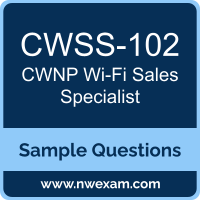 Before you write the CWNP Wi-Fi Sales Specialist (CWSS-102) certification exam, you may have certain doubts in your mind regarding the pattern of the test, the types of questions asked in it, the difficulty level of the questions and time required to complete the questions. These CWNP Certified Wireless Sales Specialist (CWSS) sample questions and demo exam help you in removing these doubts and prepare you to take the test.
Before you write the CWNP Wi-Fi Sales Specialist (CWSS-102) certification exam, you may have certain doubts in your mind regarding the pattern of the test, the types of questions asked in it, the difficulty level of the questions and time required to complete the questions. These CWNP Certified Wireless Sales Specialist (CWSS) sample questions and demo exam help you in removing these doubts and prepare you to take the test.
The best approach to pass your CWNP CWSS-102 exam is to challenge and improve your knowledge. To test your learning and identify improvement areas with actual exam format, we suggest you practice with Premium CWNP CWSS-102 Certification Practice Exam. The practice test is one of the most important elements of your CWNP Wireless Sales Specialist (CWSS) exam study strategy to discover your strengths and weaknesses, to improve your time management skills and to get an idea of the score you can expect.
CWNP CWSS-102 (CWSS) Sample Questions:
01. What kind of antenna is most frequently used with indoor APs?
a) Grid
b) Parabolic dish
c) Internal
d) Yagi
02. In what frequency band does an 802.11g (ERP) device operate?
a) 60 GHz
b) 2.4 GHz
c) 5 GHz
d) Sub-1 GHz
03. Which one of the following is an example of an antenna used mostly for bridge links?
a) Panel
b) Omnidirectional
c) Parabolic dish
d) Patch
04. When controller-based APs are used, where is the WLAN defined?
a) In the controller
b) In the master AP and it is then copied to all other APs
c) In the first AP and it is then copied to all other APs
d) In each individual AP
05. Where is an omnidirectional antenna typically placed for best results?
a) Above the target coverage area
b) The edge of the target coverage area
c) Beneath the target coverage area
d) The center of the target coverage area
06. What is the maximum data rate of the original 802.11 standard DSSS PHY (Physical Layer)?
a) 54 Mbps
b) 1 Mbps
c) 11 Mbps
d) 2 Mbps
07. RF waves are comprised of what two fields?
a) Electric and magnetic
b) Frequency and wavelength
c) Phase and amplitude
d) Phase and frequency
08. You have a switch supporting 802.3at and you must power an AP that is 40 meters from the switch. What can be used to provide power to the AP?
a) Transmit Power Control (TCP)
b) Radio Resource Management (RRM)
c) Power over Ethernet (PoE)
d) Quality of Service (QoS)
09. A tablet is a single stream client with one radio and one antenna. What 802.11 features is definitely not supported on this device?
a) MIMO (Multiple-Input/Multiple-Output)
b) DRS (Dynamic Rate Switching)
c) Authentication
d) Association
10. What must be defined in order to properly determine capacity requirements?
a) Number of devices alone
b) Number of devices and application characteristics
c) Firmware version on neighboring network APs
d) Application characteristics alone
Solutions:
|
Question: 01
Answer: c
|
Question: 02
Answer: b
|
Question: 03
Answer: c
|
Question: 04
Answer: a
|
Question: 05
Answer: d
|
|
Question: 06
Answer: d
|
Question: 07
Answer: a
|
Question: 08
Answer: c
|
Question: 09
Answer: a
|
Question: 10
Answer: b
|
Note: If you find any error in these CWNP Wireless Sales Specialist (CWSS) sample questions, you can update us by write an email on feedback@nwexam.com.
 Before you write the CWNP Wi-Fi Sales Specialist (CWSS-102) certification exam, you may have certain doubts in your mind regarding the pattern of the test, the types of questions asked in it, the difficulty level of the questions and time required to complete the questions. These CWNP Certified Wireless Sales Specialist (CWSS) sample questions and demo exam help you in removing these doubts and prepare you to take the test.
Before you write the CWNP Wi-Fi Sales Specialist (CWSS-102) certification exam, you may have certain doubts in your mind regarding the pattern of the test, the types of questions asked in it, the difficulty level of the questions and time required to complete the questions. These CWNP Certified Wireless Sales Specialist (CWSS) sample questions and demo exam help you in removing these doubts and prepare you to take the test.